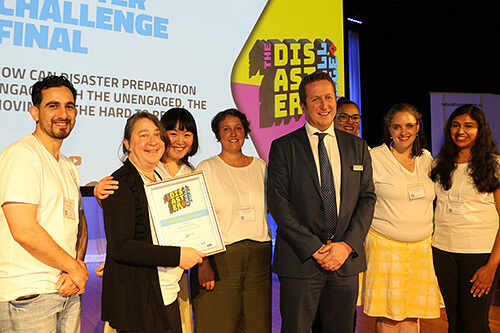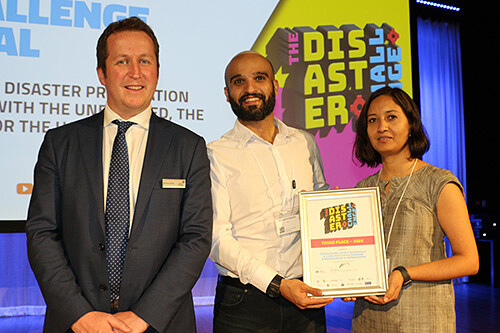
An innovative idea to use wi-fi to provide tourists with localised disaster preparedness information while on holiday has taken out the inaugural Natural Hazards Research Australia Disaster Challenge Final in Brisbane.
Dr Kamarah Pooley and Mark Owens are behind the winning concept, which addresses the wicked problem posed for the Disaster Challenge: How can disaster preparation engage with the unengaged, the moving or the hard to reach?
“Our solution to the wicked problem is to use wi-fi captive portals to reach tourists and tourism workers with disaster preparation and prevention information,” explained Kamarah, an early career researcher from Fire and Rescue New South Wales.
The idea focuses on positive and practical information that people can use while on holiday to stay safe from floods, bushfires, cyclones and other natural hazards.
The concept would see a short video play before tourists accessed wi-fi services at their accommodation or eateries. The video would include tips about how to access emergency information and what to do if a disaster struck – all customised to the local area.
“Accessing free wi-fi is essential for holiday makers and our approach is another way to reach people who are hard to reach through current communication channels,” said Mark, an early career researcher from the Country Fire Authority in Victoria.
“Wi-fi portals are a way that holiday makers can receive the vital information they need to make informed decisions during a natural hazard.”
The inaugural Disaster Challenge was held on 13 October, the United Nations' International Day for Disaster Risk Reduction, as part of the Natural Hazards Research Forum. The Challenge invited postgraduate students and early career researchers to present solutions to the wicked problem.
Natural Hazards Research Australia CEO Andrew Gissing said that the Disaster Challenge highlighted the new research and creative thinking Australia needs to face future disasters.
“Emergency management is full of wicked problems and new thinking is our way forward. We cannot keep doing things the same way and expecting a different result,” Andrew explained.
“The three innovative solutions we saw in the Disaster Challenge drew on the creativity of our best and brightest minds. We saw the benefits of combining new thinking with existing expertise, as well as the next generation – whether that be younger people starting out their careers – or others bringing their experiences into disaster management for the first time.
“There is so much we can learn and it is concepts like these that will make a difference and keep Australians safe.”
Natural Hazards Research Australia will now work with Kamarah and Mark over the next 12 months to explore their concept further, which is explained in the short video below.
Second place in the Disaster Challenge went to Griffith University postgraduate students Jane Toner, Sheridan Keegan, Ahmed Qasim, Lynn Lue-Kopman, Yunjin Wang and Manori Dissanayaka, alongside Cristina Hernandez-Santin from RMIT University. Their pitch was a disaster-activated information hub that harnessed the value of creative place making and art to bring communities together and provide emergency information to tourists, titled Beacons of Hope.

Third place was awarded to Jyoti Khatri K C and Mohammed Alqahtani, Queensland University of Technology PhD students, who drew on their personal experience of the 2022 Queensland floods with their proposal to harness community connections with culturally and linguistically diverse communities to increase emergency preparedness amongst migrant communities whose knowledge of potential natural hazards in Australia may be low.

The inaugural Disaster Challenge was coordinated by Natural Hazards Research Australia, hosted with support from universities and emergency management organisations in Queensland: Australian Red Cross, CQUniversity, Griffith University, Healthy Land and Water, Inspector-General Emergency Management Queensland, James Cook University, Office of the Queensland Chief Scientist, Queensland Fire and Emergency Services, Queensland Police Service, Queensland Reconstruction Authority, Queensland University of Technology, University of Queensland, University of Southern Queensland and University of the Sunshine Coast.
The Disaster Challenge will next take place in 2023.
For interviews and further information contact Nathan Maddock, Communications Manager, Natural Hazards Research Australia. 0410 998 600, nathan.maddock@naturalhazards.com.au
